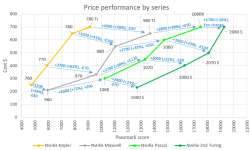Right Ive made some more modifications which to me, make sense as to how to represent the progression.
Firstly, you may not agree but I have eliminated the 1st release of Turing completely. It just doesn't fit with the historical pattern and if you consider the super range as what Turing should have been, things make much more sense.
Secondly I have eliminated the 2080 Ti. Again, it just does not fit and the progression from Pascal to Turing super range makes much more sense. In fact, the successor to the 1080 Ti is clearly the 2080 super, not the Ti, and the successor to the 1080 is the 2070 Super, and the successor to the 1070 is the 2060 super. You can see what I have done in my chart annotations below.

My final comment is that whilst the percentage increases are reducing from generation to generation, the increments in raw scores are actually pretty similar. As anyone who works with percentages knows, you do have to be careful interpreting them because as the numbers get larger, the percentages look smaller for a given increase. This is exactly what we're seeing here.
Also Turing super release is cheaper, along the upgrade path I have indicated, than Pascal was.
Yes I agree with you, the increment between 1080 Ti and 2080 Super was poor as you can see on my latest chart above. We would have expected it to be further to the right. However then it would start interacting with the dud card 2080 Ti which is a major outlier in this sequencing. I think that is the crux of the matter. 1st Turing was clearly awful.





